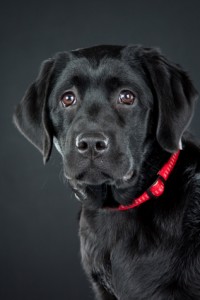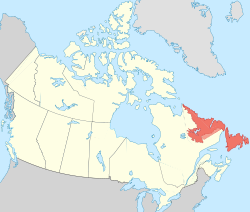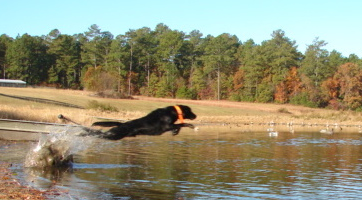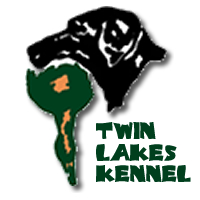
Introduction to the Labrador Retriever
According to the American Kennel Club (AKC), the Labrador Retriever is in the class of Sporting dogs. They are considered a flushing dog that will retrieve downed game for their hunter master. The Labrador Retriever graduates from Twin Lakes Kennel and their owners have proven our training methods on waterfowl and upland birds from South America to Alaska. According to the AKC rankings, Labs have come to be one of the favorite family house pets in America today, ranking Nunber One for the past decade. They are intelligent, energetic, gentle, loyal and playful. If properly socialized, which we begin immediately, they can easily live along side other pets around the house.
Brief History of the Labrador Retriever
The history of the Labrador Retriever can accurately be traced back to the late 1700’s. The Labrador Retriever did not come from Labrador. They originated in Newfoundland. There were two common breeds known as the Greater Newfoundland and the Lesser Newfoundland. The Lesser Newfoundland was a smooth coated black dog unrivaled for hardiness and stamina. The area was populated with a small water dog, which, when bred with the Newfoundland breeds, produced a new breed called the St. John’s Water Dog.
The Lesser Newfoundlands were the constant companions of fishermen of the Labrador Sea, catching fish that came loose from the lines and trained to jump into the icy waters to help pull in the nets. The Lesser Newfoundland developed a wide-spread reputation for its hunting and retrieving abilities. Early in the 19th century, the Earl of Malmesbury reputedly saw one of the dogs of this type and had it imported. In Great Britain, it became very popular on the large estates, and breeding programs by the estate owners were put into place. Virtually all of those dogs came from the kennels of the Dukes of Buccleuch and the Earls of Malmesbury, who must be credited with preserving the integrity of the new breed of hunting retriever.

The temperament of the St John’s Water Dog is documented back to the early days in England and had made them ideal family pets as well as accomplished sporting dogs. In 1830, British sportsman Colonel Hawker, the celebrated wildfowler and one of the foremost shooters of his time, referred to the breed as “by far the best for any kind of shooting, he is generally black and no bigger than a pointer, very fine in legs, with short smooth hair and does not carry his tail so much curled as the other; is extremely quick running, swimming and fighting … chiefly used on the native coast by fishermen, Their sense of smell is hardly to be credited; in finding wounded game there is not a living equal in the canine race.”
The dogs were not known as Labradors until the Earl of Malmesbury admitted that he “always called [his] Labrador dogs.” In 1887, the third Earl of Malmesbury wrote to a friend, “We always called mine Labrador dogs, and I have kept the breed as pure as I could from the first I had from Poole (Harbour), at that time carrying on a brisk trade with Newfoundland. The real breed may be known by their having a close coat which turns the water off like oil, above all, a tail like an otter.”
 The Territory of Labrador, now the easternmost province of Canada, is just northwest of Newfoundland Island, geographically. Richard Wolters in his book, The Labrador Retriever, writes that the 19th century Brits lumped that area together as the same land mass, so the name Labrador could have referred to dogs from that general area. During the 1880’s trade with Newfoundland broke down and the Quarantine Act of 1885 stopped the importation of the Lesser Newfoundland dog into England. During the same period, all the districts in Newfoundland banned the keeping of all dogs. The breed was virtually destroyed in the Island, but a few of the old breed were found in remote areas during the 1930’s. Many Labradors were interbred with other types of retrievers, but luckily, the breed prevailed and fanciers drew up a definitive standard.
The Territory of Labrador, now the easternmost province of Canada, is just northwest of Newfoundland Island, geographically. Richard Wolters in his book, The Labrador Retriever, writes that the 19th century Brits lumped that area together as the same land mass, so the name Labrador could have referred to dogs from that general area. During the 1880’s trade with Newfoundland broke down and the Quarantine Act of 1885 stopped the importation of the Lesser Newfoundland dog into England. During the same period, all the districts in Newfoundland banned the keeping of all dogs. The breed was virtually destroyed in the Island, but a few of the old breed were found in remote areas during the 1930’s. Many Labradors were interbred with other types of retrievers, but luckily, the breed prevailed and fanciers drew up a definitive standard.
Neither the Buccleuch dogs nor the Malmesbury dogs ever appeared in competition. It is, however, from the careful and dedicated importation and breeding by these kennels, including the Radclyffe family, in the earliest days of the breed’s history, that the bloodlines of the pure bred Labrador became established in England. We owe a huge debt of gratitude to these men and others like them, for their diligence in protecting and preserving the bloodlines of the Labrador we love and enjoy, today.
Current Status of Labrador Retrievers in America.

Accurate pedigrees of today’s Labrador Retrievers can be traced back to1878. The Labrador retriever was finally recognized as a distinct breed by the English Kennel Club in 1903. The first registration of Labradors by the American Kennel Club was in 1917. During the 1920s and ‘30s, there was a great influx of British dogs that formed the backbone of the breed in this country. The Labrador Retriever Club recognizes the importance of keeping the Lab true to its original purpose and requires that before the Club will recognize a conformation championship, the Lab must also have a Working Certificate, to prove that it meets minimum standards of field work.
 Twin Lakes Kennel, and its owners, Woody and Judi Thurman, are members of the American Kennel Club, the Labrador Retrievers Club and Ducks Unlimited. They continue in the rich tradition of preserving the integrity of the bloodlines of the American Labrador Retriever. For the past 35 years, they have searched for the most dominant American field bloodlines and bred for natural hunting instinct and tractability. They have produced more than eight thousand world-class Labrador Retrievers during this time.
Twin Lakes Kennel, and its owners, Woody and Judi Thurman, are members of the American Kennel Club, the Labrador Retrievers Club and Ducks Unlimited. They continue in the rich tradition of preserving the integrity of the bloodlines of the American Labrador Retriever. For the past 35 years, they have searched for the most dominant American field bloodlines and bred for natural hunting instinct and tractability. They have produced more than eight thousand world-class Labrador Retrievers during this time.
Online Sources: American Kennel Club, PetWave.com, BarkBytes.com and DogBreedInfo.com
Are you interested in learning more about labrador retriever puppies for sale by Twin Lakes Kennel? Call us for more information at (910) 462-3246 to purchase a world class Labrador Retriever from Woody Thurman today!
About Woody Thurman: Woody and Judi Thurman of Twin Lakes Kennel have been breeding and training world class Labrador Retrievers for more than 35 years. Twin Lakes Kennel is the number #1 resource for Labrador Retriever puppies. We select from the most dominant American field bloodlines and breed for natural hunting instinct and tractability. Our Labs, both puppies and adults, are out of the top working Labrador Retriever bloodlines in the country. The end results are the most talented, well rounded Labrador Retrievers possible, making them a most desirable family pet.
More than eight thousand (8,000) Labrador Retrievers have been bred and trained during those thirty-five years. During this time, Woody has titled more than 200 AKC Master Hunter Labrador Retrievers. Woody has also qualified 47 retrievers at AKC Master Nationals. He has won the Ducks Unlimited Open Championships twice. In addition, two of his Labs, Drake and Rondy, bred and trained at Twin Lakes Kennel, are in the Master National Hall of Fame.
Our Labrador Retriever puppies are the culmination of a 30 year search for the most talented, well rounded Labrador Retriever possible. We select from the most dominant American field bloodlines and breed for natural hunting instinct and tractability. Our puppies begin a structured socialization program in the litter box and are introduced to birds at six weeks.
All our Labrador Retriever Puppies carry a guarantee against hereditary defects and to have basic retrieving instincts. Parents of all our Labrador Retriever puppies are physically sound with certified hips and eyes. They are out of the top working Labrador Retriever bloodlines in the country.
We guarantee all our Labrador Retriever puppies to be free from hereditary defects.
Call Woody and Judi at (910) 462-3246 for more information.



